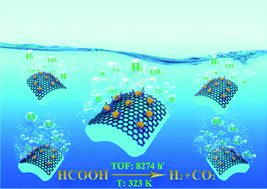Controlling the synthesis of uniform electron-deficient Pd clusters for superior hydrogen production from formic acid†
Abstract
Formic acid (FA) has been considered as a safe and convenient hydrogen carrier. Via an efficient catalytic process, hydrogen with the weight percentage of 4.4 wt% can be released in situ for onsite fuel cell applications. Herein, we report the coating of the surface of amino-functionalized SiO2 by diamine-modified graphene oxide as a superior support of Pd clusters (AP-SiO2@PDA-NGO@Pd) for robust hydrogen production from formic acid without any additives. The TOF value can reach 8274 molH2 molPd−1 h−1 at 323 K and 18 625 molH2 molPd−1 h−1 at 338 K with the complete conversion of FA, nearly 100% H2 selectivity and non-detectable generation of CO, surpassing that of all the heterogeneous catalysts reported to date. Detailed experiments proved that the modification of SiO2 and graphene oxide with chemicals containing amino groups as a catalyst support was essential for determining the morphology and chemical status of the Pd clusters. Electron-deficient Pd plays an important role in boosting the activity of the catalyst. Accordingly, DFT calculations reveal that the terminal –NH2 of the PDA functional groups on NGO can serve as proton reservoirs with suitable binding capability towards the H* species, which promotes the dehydrogenation of the FA molecule in addition to being beneficial for H* detachment to form H2.



 Please wait while we load your content...
Please wait while we load your content...